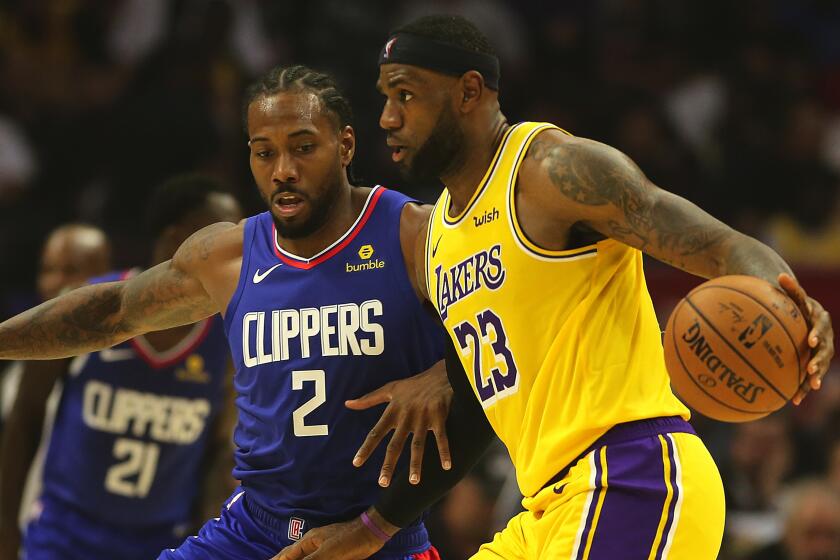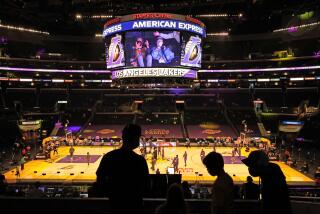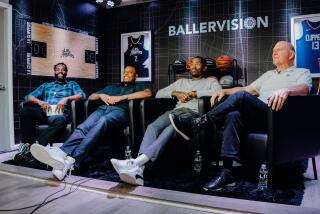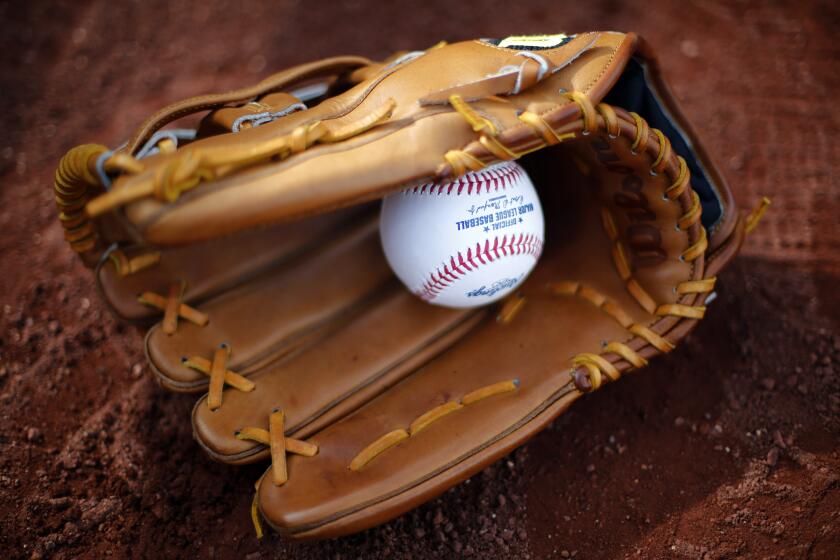How the digital fan experience in the NBA bubble works — usually
- Share via
ORLANDO, Fla. — This was the season that Payman Benz expected to watch his beloved Clippers chase an NBA championship from seats so close to Staples Center’s court that Benz once heard a referee own up to a blown call.
A pandemic changed those plans.
Unable to use his season tickets in section 111, Benz instead turned to his next-best option last month. While the Clippers prepared to play New Orleans more than 2,500 miles away in the NBA’s bubble near Orlando, Fla., Benz walked into his home office in Los Angeles early on a Saturday morning and logged in to a Microsoft videoconference.
For the next two-plus hours Benz could be seen on a 17-foot-tall videoboard ringing a court at the Disney World sports complex. A live video feed from his laptop’s camera had been digitally stitched amid those of 319 other fans. He was skeptical at first that the technology would provide anything but a gimmicky facsimile of the fan experience he was used to. A Hollywood television director, Benz was wary of being seen in the background of the game broadcast looking anything but locked in.
“If you end up on TV, you don’t want to be doing something embarrassing,” he said. “Whenever I took a bite, I slid out of frame, because I didn’t want to be George Costanza with, like, an ice cream sundae all over my face.”
But by game’s end he was digitally high-fiving fans “seated” around him and felt more engaged than he could remember watching from home. Separated by the same virus that removed the NBA from its home arenas in March, the fans felt oddly together.
“With basketball coming back, it was a little strange because you can’t watch it with anyone; everyone’s at home, watching alone,” said Benz, who has virtually attended three games. “There’s something nice about having a communal experience.”
This is what NBA fandom looks like during a pandemic: hundreds of fans doing “The Wave,” wiggling their arms and hands to distract opposing free-throw shooters, cheering for baskets and screaming after mistakes, just like old times. There is no longer any need to fight traffic or stand in line for pricey concessions. The league’s virtual crowds have included pets. Celebrities such as Lil Wayne, Dwyane Wade and Shaquille O’Neal, who would normally only be caught courtside, mingle among fans with upper-deck budgets.
“I don’t think we ever could have predicted the reception we’ve gotten for it,” said Sara Zuckert, the NBA’s head of Next Gen Telecast. “But it’s been great.”
Zuckert joined the league six years ago and for the last two has overseen efforts to innovate the television broadcasts through which the overwhelming majority of the NBA’s fans experience the league. Only 1% of its worldwide audience will attend a game in person, she said. Before the league suspended its season in March because of the coronavirus pandemic, however, none of Zuckert’s time had been spent considering a scenario in which 100% of fans would be watching on screens.
To virtually integrate fans into buildings where they are physically prohibited, the league worked with Microsoft to digitally add 10 sections of “seating” at the games, holding 32 fans apiece, on videoboards that have become the league’s default backdrop. Zuckert said the league held discussions with the National Basketball Players Assn. to ensure the look wouldn’t be too distracting. Apparently, that has not been an issue.
“You don’t really notice the fans around you on the screens,” Clippers center Ivica Zubac said. “It’s much more quiet.”
The home team disburses its free “tickets” — or, in this case, log-in codes, to Microsoft’s Teams product — however it likes. Clippers season ticket-holders were given the first opportunity to sign up, which is how Benz watched three games. Marcus Rhodes, a dentist in Houston, received a code because of his work through a local mentoring nonprofit that had a connection to the league.
The NBA reserves a handful of tickets, as well, which it uses for sponsors or other guests. Some players’ young sons and daughters have watched their fathers play virtually. A group of students from LeBron James’ I Promise School attended an Aug. 5 game between the Lakers and Oklahoma City Thunder. If fans log out early, others typically wait on standby, ready to fill their place.
Once logged in, fans see and hear the others in their section, including a team-appointed moderator checking for unruly behavior while watching a feed sent directly from NBA Entertainment’s headquarters in Secaucus, N.J.
“They’re reacting about a second-and-a-half to two seconds behind the action on the court,” said Steve Hellmuth, the NBA’s executive vice president of media and technology.
The league tested its setup using Teams’ Together Mode technology throughout the spring, but those dry runs didn’t lower Zuckert’s stress while she watched — remotely from home, appropriately — as the videoboards fired up at Disney World for the first time in July.
“That moment of being able to see that it was working, being able to see through a camera angle into the arena, was fantastic,” she said.
Still, there were kinks. When one fan needed IT help during a Clippers game, Benz and the rest of the group had to overhear the entire conversation. During later games Benz watched, a separate channel was created for such issues.
Rhodes prepared chicken wings and soda to enjoy during Houston’s game but had so much trouble logging in he thought he’d miss it entirely. Once inside, the action from the NBA’s feed was several seconds behind what was happening on his television. Such a start made him skeptical, but eventually he was won over.
“I thought, OK, this is just going to be awkward all game, and we’re just going to be sitting there, either watching the game or looking at each other,” Rhodes said. “But I was surprised how I just felt like I was watching a normal game. Honestly, I didn’t think that element of it would happen.”
With the Lakers and Clippers each a win away from squaring off in the NBA playoffs, it’s time to embrace the impending showdown between the peaking rivals.
The feasibility of hosting fans in arenas next season remains unclear as the country remains slow to contain the novel coronavirus. The Centers for Disease Control and Prevention told public health officials last month to prepare to distribute COVID-19 vaccines as early as Nov. 1, but some health officials view that date warily, noting the amount of work still to be done. Last month, NBA commissioner Adam Silver said that starting the next season on Dec. 1 as proposed feels “a little bit early.”
If fans can’t reenter arenas, or do so in sharply reduced numbers, virtual attendance could last longer than the league’s so-called bubble. Benz was sent a survey from the league after one game that asked how much he would be willing to pay for such virtual seating in the future. Benz enjoyed the experience but isn’t sure he’d spend money not to be in an arena. Rhodes, who does not have Rockets season tickets, would consider paying for “a game or two” because of the convenience. He thought it could make it easier for kids he has worked with through the nonprofit to attend.
There is another appeal too.
“Because we haven’t been a large group in a while, I definitely did kind of feel like, ‘Wow, there’s just a sense of a community again,’” Rhodes said. “Like, all right, I can actually interact with this amount of people at once again? It did feel a little refreshing.”
League officials and teams continue to tinker. The pair of hosts who normally work the Staples Center crowd during Clippers games now drop into virtual sections to solicit cheers that are mixed into the audio heard inside the Disney World gyms.
Early on, the NBA had a sense its idea was working. Less than a week after games officially restarted in the bubble, Phoenix’s Devin Booker rose for his game-winning shot to beat the buzzer, and the Clippers, on Aug. 4. When the broadcast showed a low-angle, slow-motion replay of the shot, a wall of virtual fans could be seen in the background behind him, clasping their heads in horror.
Owing to the slight delay, their reaction wasn’t in real time. But it revealed real emotions, experienced together.
“He hit the shot and it was just, like, dead silence in our section,” Benz said. “Of all the experiences I had in the three games I watched, that was the one that felt like being in an arena, because there was weight on it and the novelty wore off. It was just like, ‘Oh my god, we just got our hearts broken, and America saw it.’”
More to Read
Go beyond the scoreboard
Get the latest on L.A.'s teams in the daily Sports Report newsletter.
You may occasionally receive promotional content from the Los Angeles Times.












